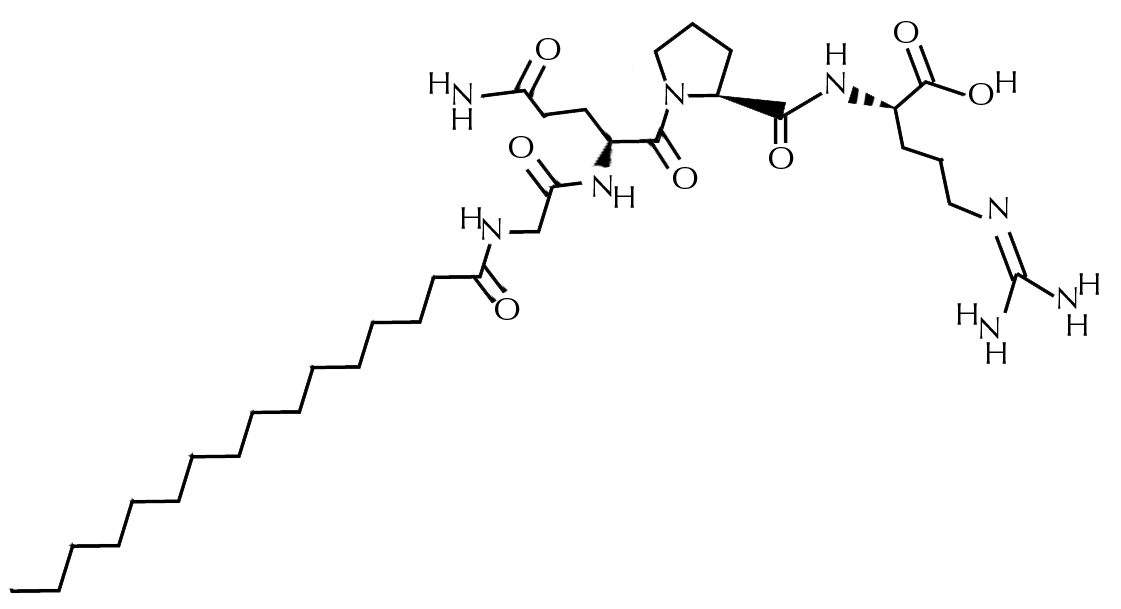What Are Palmitoyl Oligopeptides?
Many skincare blogs and reference websites provide confusing information about this group of skincare ingredients. Palmitoyl oligopeptides are the name of both the group of ingredients and the name of one specific ingredient. Palmitoyl oligopeptides are named after the first ingredient that was discovered. The subsequent ingredients with similar chemical structures were identified and given different names to characterize their structure and difference in function. However, the first discovered palmitoyl oligopeptide kept its name and became the name for this group of ingredients.
Palmitoyl oligopeptides are peptide or small proteins, characterized by a generic structure of a string of amino acids. Generally, palmitoyl oligopeptides have similar uses in skincare, and cosmetic formulations are often used as an anti-aging ingredient. They are thought to be beneficial in anti-aging formulations due to their potential to help stimulate collagen production and promote healthy cell functioning. The three most commonly used palmitoyl oligopeptides in skincare formulations are palmitoyl tripeptide-5, palmitoyl tetrapeptide-7, and palmitoyl oligopeptide. They are all synthetically made

Palmitoyl Tetrapeptide-7
the good:May help to improve the appearance of the skin by supporting collagen production and improve general skin cell health.
the not so good:It is a relatively new ingredient that has not been as well researched as other ingredients such as ascorbic acid or hyaluronic acid.
Who is it for? All skin types except those that have an identified allergy to it.
Synergetic ingredients:Works well with most ingredients
Keep an eye on: Keep an eye out for more research into this ingredient
What Is Palmitoyl Tetrapeptide-7 and How Does It Work?
Palmitoyl tetrapeptide-7 is a type of synthetic peptide compound that combines several chains of amino acids. It is primarily used in anti-aging skincare formulations to help support healthy collagen production and cell function.
Through research into this peptide, it has been identified that palmitoyl tetrapeptide-7 may stimulate the regeneration of collagen fibers in the dermis by acting as a cellular messenger. Palmitoyl tetrapeptide-7 is also thought to increase the amount of hyaluronic acid in the skin, which can help tighten skin by attracting moisture to the epidermis.
Palmitoyl tetrapeptide-7 is one of many peptides that have recently been discovered that are used due to the positive effect on skin health. Peptides are chemicals that exist naturally, but many cosmetic companies are now creating them synthetically, in the lab, to achieve greater control over how they affect the skin. Most peptides are made of chains of amino acids, which are directly involved in the creation of proteins in the body.
Palmitoyl tetrapeptide-7 is most often found in anti-aging serums, moisturizers, and in some cosmetic formulations. In a study reviewed by the Cosmetic Ingredient Review Expert Panel, the results indicated that there was a statistically significant increase in skin elasticity, a reduction in deep wrinkles, and improved skin texture. It was also found to have a dose-response for collagen 1, fibronectin, and hyaluronic acid synthesis. Collagen 1, fibronectin, and hyaluronic acid have all been associated with the aging process.
Potential Benefits of Palmitoyl Tetrapeptide-7
Palmitoyl tetrapeptide-7 is mainly used in anti-aging products for its ability to help improve the skin’s visible elasticity. Some newly reported effects that are still under investigation are; involvement in the body’s inflammation process, potentially helping to reduce cell damage during inflammation, pigmentation, uneven skin tone, and some studies suggest it may help in reducing the appearance of rosacea. This research is relatively new, and while it is promising, it is important to understand that multiple studies need to suggest these potential benefits before they can be recognized as selling points for the ingredients. At the moment, the research is not significant enough to make these claims.
Is Palmitoyl Tetrapeptide-7 Safe?
The Cosmetic Ingredient Review Expert Panel, a group that reviews the safety of skincare and cosmetic ingredients, has reviewed the available data on palmitoyl oligopeptides and has determined they are safe for use. There are no reported issues in terms of sensitivity, toxicity, or hormone disruption. However, palmitoyl tetrapeptide-7 is a relatively new ingredient. While there is a respectable amount of research on its effects, further information will be reviewed by the Cosmetic Ingredient Review Expert Panel. As they mentioned in their report, given the similarity in structure to other peptides in the body, they have the potential to interact with different pathways in the body.
There are reported side effects relating to pigmentation. This ingredient’s ability to break down skin pigment could lead to skin discoloration issues. If you’re planning to add products with palmitoyl tetrapeptide-7 to your routine, do so gradually, and preferably under the care of your dermatologist.
References:
El Hadmed, H & Castillo, R, 2016. ‘Cosmeceuticals: peptides, proteins, and growth factors’, Journal of Cosmetic Dermatology, vol. 15, is. 4, pp 514-519. Schagen, S, 2017. ‘Topical Peptide Treatments with Effective Anti-Aging Results’, Cosmetics, vol. 4, is. 2. Apone, F, Barbulova, A & Colucci, M, 2019. ‘Plant and Micoralgae Derived Peptides Are Advantageously Employed as Bioactive Compounds in Cosmetics’, Frontiers in Plant Science, vol. 10. Johnson, w et al. 2018. ‘Safety Assessment of Tripeptide-1, Hexapeptide-12, Their Metal Salts and Fatty Acyl Derivatives, and Palmitoyl Tetrapeptide-7 as Used in Cosmetics’, International Journal of Toxicology. Trookman, N, Rizer, R, Ford, R, Ho, E & Gotz, V, 2009. ‘Immediate and Long-term Clinical Benefits of a Topical Treatment for Facial Lines and Wrinkles’, Journal of Clinical and Aesthetic Dermatology’, vol. 2, is. 3, pp. 38-43.







